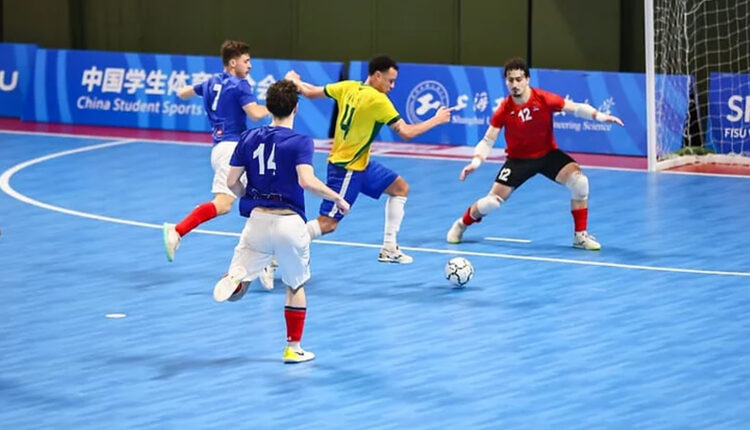Futsal Rules: The Complete Guide for Beginners
A Deep Dive into the Rules and Particularities of Futsal

Understanding the Basics of Futsal
Futsal, a dynamic and fast-paced version of soccer, is growing in popularity worldwide. The game is played indoors on a smaller court, which adds to its high-intensity nature. Typically, futsal matches are played with two teams of five players each, including a goalkeeper. Unlike traditional soccer, futsal has a strict set of rules that govern its unique gameplay, making it essential for beginners to grasp these regulations before stepping onto the court. Knowing these basics not only enhances the playing experience but also equips players to enjoy the sport safely and competitively.
The Court and Equipment
A futsal court differs significantly from a traditional soccer field. It measures between 25 to 42 meters in length and 16 to 25 meters in width. The surface is usually made of wood or a synthetic material, designed to enhance ball control and reduce the likelihood of injuries. Players wear indoor shoes with non-marking soles, which are crucial for optimal performance and traction. The ball used in futsal is smaller and has less bounce than a regular soccer ball, providing better control and allowing for a faster-paced game. Each element, from the playing surface to equipment, contributes to futsal’s distinct characteristics.
Player Positions and Roles
In futsal, every player has a specific role, contributing to the overall team strategy. The goalkeeper is crucial and often initiates attacks with quick throws or passes. Outfield players are generally divided into defenders, wingers, and a pivot (the target player). Each position demands versatility and quick decision-making, as players switch roles frequently during the game. Unlike in outdoor soccer, where positions are more fixed, futsal encourages fluidity and creative play. Understanding these roles is essential for new players aiming to develop effective strategies and enhance their skills on the court.
Key Rules and Regulations
Understanding futsal rules is vital for a seamless game experience. A match lasts 40 minutes, divided into two halves of 20 minutes each. One key rule is the absence of offside, which encourages continuous and fluid gameplay. Teams are allowed to make unlimited substitutions, ensuring players stay fresh. However, substitutions must occur at designated zones to maintain order. Fouls are another significant aspect; after the fifth accumulated foul, each team foul results in a direct free kick. These distinctive rules shape futsal’s gameplay, emphasizing skill and teamwork over physical endurance.
Fouls and Free Kicks
Fouls in futsal are strictly monitored to maintain a fair and safe playing environment. A player committing a foul can result in a variety of sanctions, including direct free kicks. Unlike outdoor soccer, sliding tackles are generally prohibited to prevent injuries. After the fifth team foul in a half, all subsequent fouls lead to a second penalty spot kick, adding a layer of complexity to defensive strategies. Understanding the implications of fouls is crucial for beginners, as it affects the game’s flow and team tactics. Being mindful of fouls helps maintain control and keeps the match competitive.
Goalkeeper Rules and Responsibilities
The role of a goalkeeper in futsal is uniquely challenging and pivotal. Goalkeepers are allowed to play in any part of the court, but have only four seconds to release the ball when inside their own half, emphasizing speed and precision. Furthermore, they cannot handle the ball outside their penalty area. Understanding these limitations allows goalkeepers to effectively contribute to both defensive and offensive plays. Awareness of these specific rules ensures the game’s rhythm is maintained and keeps the play dynamic and engaging for all players involved.
Strategy and Team Dynamics
Strategy in futsal is constantly evolving due to the small playing area and quick pace. Teams often employ formations that maximize both offense and defense, such as the 2-2 formation or the 3-1 setup. Communication is key; players must be aware of their positions and dynamics, reacting swiftly to changes in play. Agile footwork and precise passing are essential for maintaining possession and creating scoring opportunities. By embracing strategic team dynamics, players can elevate their level of play, making each match an exciting challenge that tests skill and teamwork.
Embracing the Excitement of Futsal
Futsal offers a unique adaptation of the beautiful game that enthralls players and spectators alike. Its emphasis on skillful ball control, fast-paced action, and strategic teamwork make it a thrilling sport to learn and play. As a beginner, understanding the fundamental rules and dynamics of futsal is crucial for enjoying the game to its fullest. By absorbing the essentials of court play, player roles, and strategic nuances, newcomers can immerse themselves in the excitement of futsal, experiencing the sport’s intensity and the camaraderie it fosters.
